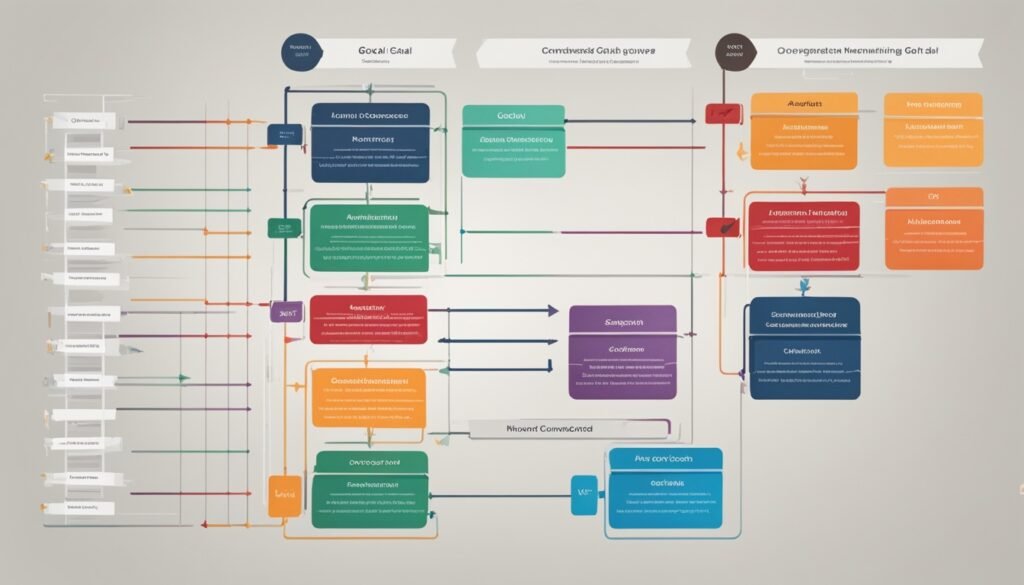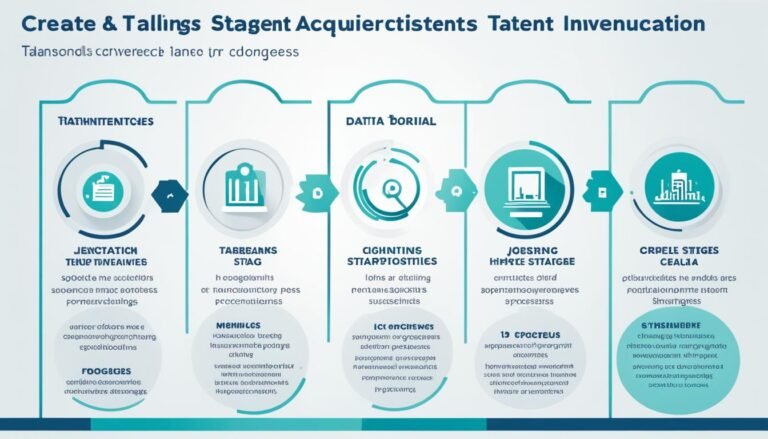How do managers effectively set and achieve organizational goals?
Did you know that only 25% of organizations said they met their goals? This shows that reaching organizational goals is tough. It needs strategic planning, clear communication, and continuous support. In this writing, we’ll look at how managers can set and meet goals. We want to make sure their teams and companies succeed.
Key Takeaways:
- Regular check-ins, meaningful conversations, and ongoing feedback are essential for effective goal setting.
- SMART goals (Specific, Measurable, Achievable, Relevant, and Time-bound) provide clarity and direction.
- Clear planning, organizing resources efficiently, and effective leadership are crucial for goal attainment.
- Communication plays a vital role in aligning efforts and maintaining motivation.
- Training programs help employees acquire the necessary skills for goal achievement.
The importance of effective goal setting in management
Effective goal setting is key to a company’s success. It gives employees a clear path forward. Goals help everyone work together towards what the company wants to achieve. They boost motivation, engagement, and make people work better.
Clear goals act like a compass for employees. They show the way and why their work matters. This understanding makes people feel like they’re making a difference. It makes them happier and more committed at work.
Managers also win with good goal setting. It guides them in using resources wisely and spotting chances. With the right goals, organizations can get ahead and grow. Setting goals carefully is a strategy for success.
Moreover, good goals lead to better efficiency. They help manage and track progress. This makes it easier to adjust and keep moving towards success. Checking in on goals regularly ensures everyone stays on the right path.
“Effective goal setting provides a clear direction and focus for employees, promotes motivation and engagement, and improves performance and productivity.” – John Maxwell
In conclusion, effective goal setting is crucial in management. It brings everyone together, boosts motivation, and improves choices. By setting goals that matter, companies can push towards their goals. This ensures they keep growing and innovating.
Strategies for setting effective organizational goals
Setting strong organizational goals takes thought and planning. Managers need to use smart strategies. This ensures their goals are clear, doable, and match the bigger objectives of the organization.
Using the SMART framework is a great way to set goals. SMART means your goals should be Specific, Measurable, Achievable, Relevant, and Time-bound. This helps give your team clear focus and lets you measure success easily.
Crafting a plan of action is also key. You should divide big goals into smaller steps. Then, figure out what resources you need and set a timeline. When key people help plan, everyone understands better and works towards the same goal.
Managing time and avoiding distractions are important too. Getting rid of things that pull focus helps create a more productive workspace. Choosing urgent tasks wisely, and using time management methods, ensures your team’s time and effort go towards reaching the goal.
It’s critical to track progress and celebrate wins. This keeps your team motivated and involved. By checking in on how things are going and acknowledging success, you can keep the momentum high.
| Strategies for Effective Goal Setting | Tips for Setting Organizational Goals | Goal Setting Best Practices |
|---|---|---|
| Utilize the SMART framework | Involve key stakeholders in the planning process | Mitigate distractions and employ efficient time management techniques |
| Craft a clear plan of action | Establish a timeline for goal completion | Track progress and celebrate successes |
By following these methods and best practices, managers can lead their teams to meet goals. This supports success and builds a culture of achievement in the organization.
The role of planning in effective goal setting
Planning is key for setting effective goals. It means clearly stating what you want and how you’ll get it. A clear plan is crucial for meeting goals in any setting.
Good planning gives direction. It guides people on what to do and how to do it. Essentially, it’s a guidebook outlining what step to take next.
It also helps spot potential issues and chances. This way, plans can be adjusted or prepared for any hiccups. Such thinking ahead can mean smoother sailing towards success.
A solid plan is also doable and measurable. It considers what’s on hand and the timeframe set for the goal. This ensures that the goal is achievable and progress can be checked.
It’s important to have everyone on board. Including others in the plan promotes teamwork. It makes every feel involved and aims their efforts in the same direction.
Planning strategies for goal attainment
Managers have a few tricks up their sleeves for goal planning:
- Break down goals: Smaller tasks from big goals are easier to handle.
- Set deadlines: Deadlines keep things moving and everyone accountable.
- Allocate resources: Figuring out what you need helps execute the plan better.
- Establish priorities: Setting tasks in order helps with getting things done right.
- Create contingency plans: Having a backup for when things go wrong is smart planning.
- Monitor progress: Keep an eye on how things are going and make changes where needed.
Using these strategies, managers can make sure the team reaches its goals. They’re all about efficiently meeting what the organization has set out to do.
| Benefits of planning in effective goal setting |
|---|
| Provides direction and clarity |
| Identifies potential risks and challenges |
| Ensures goals are realistic, achievable, and measurable |
| Promotes collaboration and shared responsibility |
| Creates a framework for efficient resource allocation |
Planning is fundamental for success. It’s the base that makes reaching goals possible. With the right strategies, teams will be set to win and achieve their aims.
The role of organizing in effective goal setting
Organizing is vital for reaching targets in any group setting. It involves wisely using resources to boost efficiency and meet deadlines. Setting and reaching goals strongly depends on how well we organize our efforts.
Efficient resource allocation
Allocating resources like people, materials, and tools is part of organizing. The goal is to give each task what it needs for success. This makes the work go smoothly, reducing delays and boosting output.
Establishing clear roles and responsibilities
For any goal to be hit, everyone needs to know their part. This step means making sure all roles are clear, with tasks lined up for each team member. It builds a team-focused environment where everyone knows what they’re supposed to do.
Optimizing resource utilization
Efficient organizing avoids waste and makes the best use of what’s available. This means figuring out the exact resources needed for each job. It helps the group use its resources wisely, improving the chances of reaching its goals.
Fostering a collaborative environment
Organizing tasks that need team efforts creates a spirit of working together. It pushes employees to share ideas and support each other to achieve common goals. This kind of workplace encourages new thinking, problem-solving, and teamwork, which leads to success.

The role of leading in effective goal setting
Leading is vital for good goal setting. It means getting your team inspired and motivated. Leaders guide and support their team members. They make the work environment positive, boosting teamwork and new ideas. By leading well, they set a model for the team’s performance. They also handle problems and encourage sharing ideas. This makes sure everyone works together towards success. Leaders build a culture of support and give power to their teams. This helps in reaching goals and succeeding.
Leadership Strategies for Goal Attainment
“A true leader has the ability to inspire others to achieve greatness. They possess strong communication skills, foster collaboration, and provide the necessary support and guidance to their team.” – Jane Johnson, CEO of Success Inc.
Leaders use different methods to help their teams meet goals. They make sure each team member knows what their role is. Leaders also explain the goals clearly. This gives the team a sense of direction. They support teamwork and trust. This lets team members freely share their ideas. Leaders always give feedback and praise. They aim to keep the team motivated and performing well. They also see mistakes as chances to learn, driving innovation and growth.
Leaders value the differences in their teams. They know that each member brings something special. They use these unique traits to handle challenges better. Good leaders also focus on growth, for themselves and their teams. They arrange for training to improve skills. This helps everyone better reach goals. By always improving their own leadership, they lay a strong base for success.
| Leadership Strategies for Goal Attainment | Benefits |
|---|---|
| Clear Communication | Ensures that everyone is aligned and working towards the same goals |
| Collaboration and Trust | Fosters innovation, creativity, and a supportive work culture |
| Ongoing Feedback and Recognition | Motivates team members to perform at their best |
| Diversity and Inclusion | Brings varied perspectives and strengths to drive goal achievement |
| Personal Development | Investing in training and growth to enhance skills and knowledge |
The role of controlling in effective goal setting
Controlling is key in setting and reaching goals. It means keeping an eye on progress, spotting if things go off track, and fixing them. By always watching how things are going, managers make sure goals are met the way they want.
This process keeps everyone on the same path. It lets managers make quick choices to fix any plan hiccups. Plus, it spots problems early so changes can be made. Good control means work runs effectively, saving time and money. It’s a big part of reaching goals and helps a company succeed.
| Importance of controlling | Control strategies for goal attainment |
|---|---|
| Ensures goals are on track | Regular tracking of progress |
| Identifies potential problems | Comparing progress to planned objectives |
| Allows for timely decision-making | Identifying variances |
| Facilitates resource optimization | Taking corrective action when necessary |
Good controls make sure goals are met well. Checking often, deciding fast, and solving problems quickly are key. Managers must choose control plans that fit the company’s goals. And, they should change these plans if things change.
Utilizing feedback for continuous improvement
Feedback is a great tool for getting better. Listening to what employees say can show if goals are working well. Talking openly and trusting each other is vital for good feedback. Managers can use surveys or talks to hear ideas and make smart choices.
Effective control mechanisms ensure that goals are achieved efficiently and help managers make informed decisions.
Overall, controlling is crucial in goal setting. It lets managers keep watch, fix problems, and keep going strong. With good control, businesses can use their resources well. This makes hitting their goals more likely.
The importance of communication in goal setting
Good communication is essential for any goal to succeed. It helps everyone to understand their part. By keeping communication clear and open, managers lead their teams toward reaching objectives.
When we communicate well, we explain the reasons behind our goals. This makes the team know why the goals matter. It creates unity and pushes people to work hard toward a shared achievement.
Moreover, good communication encourages working together. It lets people share ideas and feedback freely. This teamwork can lead to better plans and choices, making it easier to achieve set goals.
Feedback and support are key in goal setting through communication. It’s important to tell employees how they are doing and how they can improve. This way, everyone stays on the right path and grows continuously.
Communication also helps deal with any challenges that might come up. Managers should keep talking openly to their team. They must be ready to step in with help when needed, making sure the team has what they need to overcome hurdles and succeed.
Furthermore, good communication builds trust and strong connections in the team. It shows that honesty and sharing are valued. When people feel listened to and respected, they become more involved and aim for higher goals.
To sum up, communication is key in goal setting. It brings understanding, teamwork, and ongoing help. By communicating well, managers can inspire a culture of success, leading to the achievement of shared goals.
“Good communication is the bridge between confusion and clarity.”
Communication Strategies for Goal Attainment
For better communication in goal setting, managers can try the following:
- Be clear and concise: Avoid confusion by explaining goals and expectations clearly.
- Provide context: Talk about why the goals matter to the organization to inspire understanding and motivation.
- Encourage participation: Create a space where every team member feels safe sharing.
- Active listening: Listen to what employees have to say, showing you value their ideas.
- Regular check-ins: Meet often to give feedback, review progress, and solve issues together.
- Use multiple communication channels: Send messages through various platforms to suit different needs.
- Practice empathy: Try to understand and support your team’s challenges.
- Encourage two-way communication: Promote an environment where everyone can freely speak their mind.
- Provide ongoing training: Offer courses to help everyone improve their communication skills.
Putting these strategies into action can make a big difference in how effectively a team communicates. This, in turn, helps meet goals more successfully.
The Role of Communication in Effective Goal Setting
Communication is key in effective goal setting. It helps with understanding, encourages working together, builds trust, and ensures ongoing support. With clear, open communication, managers can build a workplace where everyone is motivated, involved, and ready to achieve shared goals. Prioritizing effective communication strategies can boost goal attainment and organizational success.
| Benefits of Effective Communication in Goal Setting | Strategies for Effective Communication |
|---|---|
| 1. Clarity and alignment | 1. Be clear and concise |
| 2. Motivation and engagement | 2. Provide context |
| 3. Collaboration and innovation | 3. Encourage participation |
| 4. Trust and accountability | 4. Active listening |
| 5. Ongoing support and feedback | 5. Regular check-ins |
These benefits and strategies highlight the vital role communication plays in effective goal setting. When used well, they lead to a work environment that encourages goal achievement and supports overall success.
Tips for effective goal setting and achievement
Managers can use many tips to set and meet goals well. These methods make goal-setting better and increase the chances of success.
1. Set SMART Goals
All goals should be SMART. This means they are clear, can be measured, realistic, fit what’s needed, and have a deadline. Doing this helps keep everyone focused and knowing how things are going.
2. Involve Key Stakeholders
It’s important to let everyone involved help set the goals. This makes sure everyone is on the same page. Working together towards a goal increases unity and commitment.
3. Regular Check-Ins and Meaningful Conversations
Regular talks with employees are key. They give a chance to offer feedback and help. This ensures everyone has what they need to succeed and stays on track.
4. Foster a Culture of Teamwork and Collaboration
Encourage teamwork and set goals that require everyone’s effort. Working together towards a team goal helps leverage everyone’s strengths. This leads to more success together.
5. Celebrate Small Wins
Don’t forget to celebrate even small achievements. Doing this boosts morale and keeps motivation high. It helps drive towards more success.
6. Adapt and Update Goals
It’s smart to adjust goals as the business changes. Keep checking goals to make sure they’re still needed. Adapt them as new opportunities or problems come up.
7. Stay Focused and Minimize Distractions
Avoiding distractions and staying focused is important. Use methods like “Eat That Frog” and the Pareto Principle to stay on the right track. These help managers spend time on what really matters for success.
8. Utilize Effective Communication Methods
Good communication is vital for everyone to work towards common goals. Use clear ways to talk and share ideas. Giving and receiving regular feedback keeps everyone engaged and helps fix problems quickly.
By using these strategies, setting and completing goals becomes easier. The focus gets sharper, employee support improves, and organizational success grows.
The role of training in goal setting and achievement
Training is key for setting and reaching goals. It’s like a smart buy that gives employees the skills they need. These skills help them do well on work projects and tasks, hitting their goals.
Training helps in special ways depending on the area. For instance, if a team needs to improve how they work together, there’s training for that. If a manager should lead better, there’s training to boost their leadership. This kind of skill training makes sure everyone can do their part in reaching goals.
| Benefits of Training in Goal Setting and Achievement | Training Strategies for Goal Attainment |
|---|---|
|
|
Managers who invest in training give their teams a big boost. It helps workers take charge of their goals. And it makes learning and growing a normal part of work.
This kind of learning helps teams do better than they thought possible. It helps everyone in the team feel good about their work. And it makes new and better ways of working happen.
To sum up, training is super important for meeting goals. It gives the needed skills and knowledge to do well on projects. With the right training, teams can achieve more and keep getting better.
Conclusion
Effective goal setting is key to reaching what a team aims to do. Using tools like regular check-ins and deep talks, managers can help workers get there. They should set SMART goals, make clear action plans, and avoid things that distract.
The steps of planning, organizing, leading, and controlling are critical for reaching goals. Good talks are essential. They keep everyone on the same page and encourage teamwork. Also, using helpful advice and training is crucial for a culture that wins.
With the right goals and steps, managers can make sure their team wins and grows.
FAQ
How do managers effectively set and achieve organizational goals?
Managers reach goals by checking in often and having meaningful talks. These talks update the team’s progress. It’s also vital to review and adjust goals to match the organization’s needs. Working together towards these goals fosters a team spirit. Cheering for small achievements can make everyone feel good and work harder.
What is the importance of effective goal setting in management?
Setting good goals is key for a successful business. It offers a path for the team to follow and keeps them driven. Knowing what they’re working for helps employees see their contribution. This brings everyone together towards a common goal.
What are some strategies for setting effective organizational goals?
Clear planning and involving the right people are top strategies. Goals should be SMART: Specific, Measurable, Achievable, Relevant, and Time-bound. Having a detailed action plan and managing time well also matter. Celebrating progress keeps the team motivated and focused.
What is the role of planning in effective goal setting?
Planning is essential in reaching goals. It lays out clear objectives and a path to achieve them. A good plan helps everyone know what they need to do. It also allows for changes along the way if needed.
What is the role of organizing in effective goal setting?
Organizing well is key in meeting goals. It means putting resources in the right places and assigning roles clearly. This boosts productivity and teamwork. Plus, it ensures work gets done on time and everyone is accountable.
What is the role of leading in effective goal setting?
Leaders are critical for goal success. They inspire the team and provide the needed support. A good leader creates a positive workplace and helps handle conflicts. They make sure everyone is ready to work towards the goals.
What is the role of controlling in effective goal setting?
Controlling is about keeping an eye on the progress. It helps spot issues early and make needed changes. By checking regularly, managers can steer their teams towards success. Good control keeps things efficient and resources well-used.
Why is communication important in goal setting?
Good communication ensures everyone knows what to do. It avoids confusion and helps with teamwork. Regular talks and feedback are crucial for keeping on track and solving problems.
What are some tips for effective goal setting and achievement?
Setting SMART goals, engaging with others, and constant updates are key. Teamwork is crucial. Celebrate each milestone achieved. Be ready to change goals if the situation demands. Always focus on learning and growing.
What is the role of training in goal setting and achievement?
Training is vital for helping the team reach its potential. It provides the skills they need to meet goals. Investing in training shows you care about their development. It encourages a culture of learning and responsibility.
What are the benefits of effective goal setting?
Good goal setting enhances focus and motivation, leading to success. It helps make better decisions and invites competition. A well-set goal cultivates a strong culture and improves the organization’s efficiency. In the end, it contributes to the company’s overall growth.








